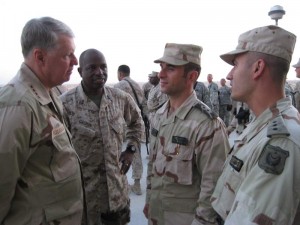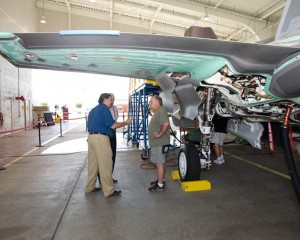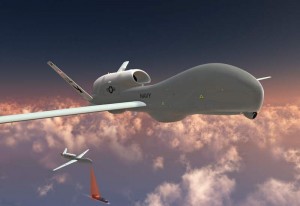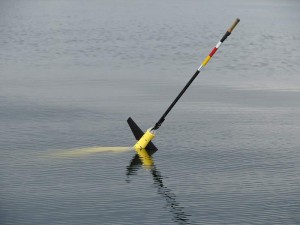Forging a 21st Century USN and USMC : C4ISR D as a Key Element for XXIst Century Power Projection Force
By Dr. Robbin Laird and Dr. Scott Truver
Dr. Scott Truver is Director of National Security Programs at Gryphon Technologies, LC ; Robbin Laird has worked with Dr. Truver on maritime issues since 1996.
This special report examines the key role of C4ISR D in allowing the USN and USMC to operate as a global power projection force.
11/18/2010 – Crafting an effective U.S. Navy and Marine Corps strategy for the 21st century––one that both supports national security and homeland security objectives and gains sustenance from them––requires a strong emphasis on networking in a broad and comprehensive context. Networks make U.S. forces more effective by enabling them to share more information on a timelier basis, thus leveraging the power of a limited numbers of units and small forces.
That said, seamless interoperability and comprehensive information sharing per se in single-service, Joint, inter-agency and combined operations will no longer, in themselves, suffice. With the growing dependence of the nation’s top-level strategies on the contributions of allies and coalition partners to the maritime defense of the global commons and to multi-national, sea-air power projection, the U.S. Navy and Marine Corps will have a greater requirement to network with American allies, partners and friends in a significantly broader, more inclusive fashion than ever before.
And the evolution of the global operations of the USN and USMC will operate in an increasingly global centric regionally based environment. The need to build effective regional coalitions among developed and developing states is a key requirement for U.S. policy in the years ahead. A major difficulty in shaping such a new security system will be maintaining a strong leadership role without generating anti-Americanism as a factor in stimulating new regional alliances against U.S. interests.
In this emerging and burgeoning “network-centric” context, the key to the effectiveness of the United States as a global power will be its ability to leverage relations in one region to achieve effects in another, i.e., its skill in reaching beyond itself in one region to engage the participation of corresponding states in other regions.
In contrast to the traditional strength of a global super power––the unilateral capacity to bring overwhelming military force to bear without regard to the requirement to work with regional states––it is this regional networking role that will now be critical for the U.S. capacity to defend its interests.
Specifically, the United States will seek to become the primary architect of a security zone extending from the Mediterranean, through Europe, across the Atlantic to the Americas, and across the Pacific into Asia and the Indian Ocean littoral. In this role, it will not act as a hegemonic power, but rather as a networking power.
The crafting of a connectivity “workspace” will be a central challenge, and the emergence of such a “workspace” among allied forces is a weapon system in and of itself.
The strategic challenge in this unique historical situation is to combine global reach with growing deftness in putting together coalitions––networks––of “the willing” to meet specific threats. This blending of military and diplomatic skills to create netted regional security arrangements will be a key U.S. goal in the 21st Century.
Thus, for the United States to have an effective military role in the new setting of regional networking, a key requirement will be effective and assured combined command, control, and communications, linked by advanced computing capabilities to global, regional, and local intelligence, reconnaissance, and surveillance assets (C4ISR).
The services will need to ensure that there is broad synergy among U.S. global forces fully exploiting new military technologies and the more modest capabilities of regional allies and partners. Indeed, C4ISR is evolving to become C4ISR D, whereby the purpose of C4ISR is to shape effective combined and Joint decision-making.
The Department or Defense and the Department of the Navy have responded to this new “cyber” environment with a major change to how DoD and DoN are organized. The Department of Defense has established U.S. Cyber Command as the command primarily responsible for dealing with new threats – and opportunities – created by the technologies that allow friend and foe to operate in this new dimension.
Additionally, for the U.S. Navy the response to this new environment has been proactive and dramatic and has been reflected by the most profound reorganization of the Navy staff in over a decade.

Concurrently, in his most recent CNO Guidance, Chief of Naval Operations Admiral Gary Roughead has made achieving “Decision Superiority” one of his top five goals for 2010. The U.S. Navy Vision for Information Dominance builds on this CNO Guidance and quotes Admiral Roughead regarding this sea change in the Navy’s use of information as a weapon:
The biggest breakthrough of the current fight in OEF and OIF is the successful integration of intelligence with operations, and using the network to get information to the right person, at the right time, in the right way. That is where the power is.
In part, this is the challenge of a technology gap; but it also means recognizing the difference of emphasis between a global power operating regionally and regional powers operating locally.
At a minimum, U.S. forces and those of America’s friends must share and exercise common command and control, with regular participation of coalition officers trained to work on combined staffs. When these prerequisites are met, the introduction and integration of compatible C4ISR systems becomes a coalition force multiplier and enables cohesive and effective integration of U.S. capabilities with those of allies and partners.
These coalition requirements demand emphasis on achieving the global transparency of command and control that will be indispensable for supporting U.S. engagements in crisis and conflict situations. In the not-too-distant future, networking will link sensor grids with diverse and dispersed platforms and bases, and situational awareness will encompass so much information exchange that the line between information providers and consumers will blur.
New Directions for Navy/Marine Corps C4ISR D
- The implications of these challenging global C4ISR D and networking requirements for the Sea Services, in some respects, are influenced by several key factors somewhat closer to home. As military services, the Navy/Marine Corps Team––complemented increasingly by the Coast Guard––is growing more dependent upon “network warfare” for several reasons: (1) a Navy and Marine Corps with fewer platforms––ships, aircraft and submarines––will need to place increased reliance on dispersed, interactive operations;
- the development of advanced communication and data transmission systems can only enhance the advantage of dispersed but interactive forces and tactics, such as the Cooperative Engagement Capability (CEC); and
- the wider use of offboard/remote sensors, e.g., satellites and unmanned aerial, surface, and undersea vehicles (UAVs, USVs and UUVs), including armed, unmanned platforms, will create its own demand for networking.
Moreover, the new 5th-generation aircraft function as “flying combat systems,” comprising substantial onboard distributed computing systems, rapid upgrades through chip/software insertions, and designed and built around a 21st-Century concept of man-machine operations. All of these trends can be expected to continue––and, indeed, to accelerate––for the foreseeable future.

With respect to force levels, today’s fleet of some 288 ships (as of September 13, 2010) is probably the maximum that can be expected in the near term, i.e., at least for the next decade. Despite a Navy force goal of 313 ships by 2020, shipbuilding budgets are not likely to provide an increase in ship construction and force levels. Rather, delays in the aircraft carrier (CVN), landing ship (LPD), and littoral combat ship (LCS) programs – to say nothing of the Navy’s truncating the DDG-1000 program at three ships – coupled with the early retirement of ships suffering from maintenance problems and exacerbated by the restructuring of the Navy’s next-generation destroyer and cruiser programs, could lead to an even smaller fleet in the near term. Fewer ships, aircraft, and submarines will place a strain on the fleet as crises and conflicts arise and continue in various parts of the world.
Widely dispersed naval forces will see an increase in the transmission of data of all types among naval forces and Joint forces/commands.
Further, the limited size of the current and future fleet has led to the “1000-ship Navy” concept, first espoused by Admiral Michael G. Mullen when Chief of Naval Operations. This concept seeks to employ allied and even neutral navies in support of mutual national interests. In his address at the 17th International Seapower Symposium at the Naval War College in September 2005, Admiral Mullen stated that an international fleet in excess of 1,000 ships, a Global Maritime Partnership, was needed to address new challenges.
In turn, this will place additional burdens on U.S. naval networks with respect to procedures, protocols, security, language, and equipment. U.S. naval networks will operate within overall U.S. proprietary military capability, with growing reliance as well on an ability to leverage commercial networks. Global maritime security depends on global information sharing: the sea is vast, ships are far between, and to be effective they must see beyond their horizons. Networking makes that possible.
Advances in communications and data sharing must be fully exploited to enhance the effectiveness of available naval forces and to enable those forces to employ offboard/remote sensors and unmanned platforms.
This will require improvements and changes in procedures and protocols, as well as the need for increased automation, as additional circuits, sensors, and unmanned platforms demand service by the Naval Information Dominance Enterprise (NIDE) infrastructure.
Figure 3: Systems such as I Robot’s robotic Sea Glider will provide significant maritime domain awareness and will need to be integrated with the fleet on flexible operations. Credit: I Robot, 2010
Further, because available bandwidth will be hard-pressed to accommodate these requirements, new concepts in how U.S. services use the available bandwidth, including time-sharing, burst communications, data routing, assignment of priorities, and other advances will be needed in naval networks.
The wide use of remote sensors and unmanned vehicles––air, surface, and underwater––will increase the need for effective networks and data links. In 2010, the Navy and Marine Corps use a large number of tactical UAVs, primarily for ISR functions.
In the near term the Broad Area Maritime Surveillance (BAMS) system will provide a high-altitude, long-endurance vehicle, with an endurance of more than 24 hours; future UAV concepts envision endurance measured in months and years.

ven at the tactical level, the decision to procure large numbers of the MQ-8 Fire Scout UAV for the LCS––i.e., more than 100 aerial drones deployed on board the planned force of some 50 LCSs––will demand new levels of networking.
The LCS in particular will bring new demands on Navy networking because, in addition to the Fire Scout UAV and manned helicopters, the various LCS configurations will operate unmanned surface and underwater vehicles in the anti-surface (ASuW), mine countermeasures (MCM) and anti-submarine warfare (ASW) mission configurations, as well as for other future roles and tasks.
More to the point of LCS, it will sit at the center of a network of unmanned sensors and pass information into wider area networks affecting tactical decisions.
Similarly, advances in underwater communications are making it possible to include underwater sensors in networks which can help a fleet with limited numbers dominate the undersea battlespace of a littoral region. Submarines, which now operate only mine detection/mapping UUVs, can also be expected to operate more unmanned vehicles in additional mission areas, especially in novel ISR operations and possible ASW roles.
And the expanded role of robotics to shape an insertion enterprise, with air, surface and underwater robotic vehicles operating together will require an enhanced information capability.
Notably, the new assets coming off of the amphib as a key element of the USN and USMC joint team, spearheaded by the F-35B will allow the management of the information system to operate within an enduring littoral presence mission set.
In the context of this increasing use of data transmission and communications by U.S. naval forces, potential adversaries will also have increased access to the means and techniques for interfering with advanced networks.
This became evident when Iraqi forces attempted to interfere with Global Positioning System (GPS) weapon guidance in the 2003 conflict and in recent––and often successful––foreign cyber attacks on U.S. government agencies and Congress, including the Department of Defense and various military and national networks.
U.S. adversaries have the advantage of agility in developing cyber-attack capabilities because of the nature of a large, complex, hierarchal institution such as the U.S. armed forces, and the ready availability of cyber-attack techniques (often disseminated on the Internet) and of commercial hardware and software.
As the perhaps overstated cliché goes, all it takes for potential enemies to devise and field cyber-attack weapons are a credit card and access to a local Radio Shack. (This is why the Marine Corps is embracing distributed operations and the Air Force is focusing on the deployed tactical network and cyber offensive operations to protect deployed forces.)
Also, critical will be relying on the new F-35s to spearhead a distributed decision making system which will make targeting a central node in the information management grid of limited effectiveness. Indeed, doing so will open the aggressor to counter strikes via electronic warfare means.
These security considerations will have profound implications for the Naval Information Dominance Enterprise.



